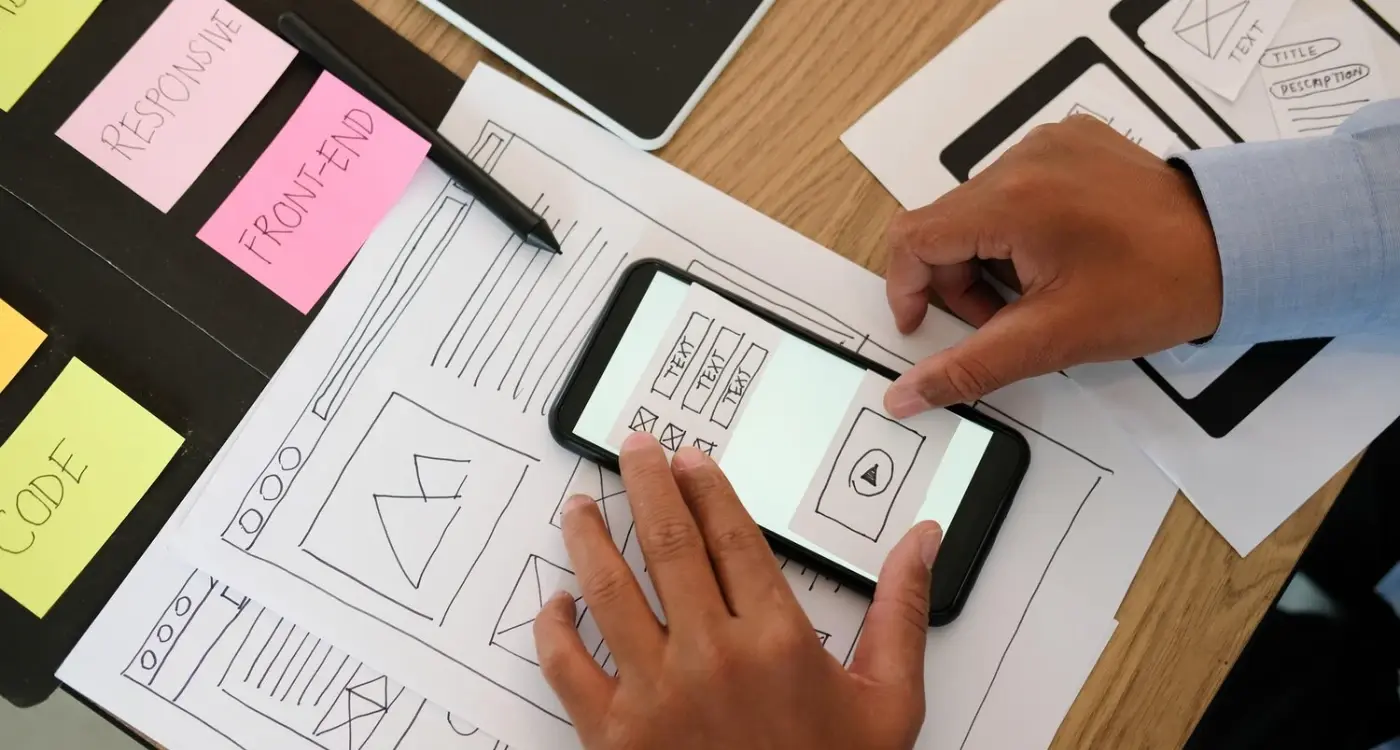How Can User Personas Strengthen Your App Feasibility Case?
Picture this: you've got what feels like the next big app idea. You're excited, you can see the potential, and you're ready to start building. But then reality hits—investors want proof, stakeholders need convincing, and you're left scrambling to justify why your app will actually work. Sound familiar? This is where most brilliant app ideas crash and burn, not because they're bad concepts, but because their creators can't demonstrate real demand from real people.
The problem is that too many app developers and entrepreneurs rely on assumptions about their target audience rather than concrete data. They think they know who will use their app and why, but when it comes to proving it—well, that's when things get tricky. User personas and app feasibility research aren't just nice-to-have documents; they're your secret weapon for building a bulletproof business case.
Understanding your users isn't just about creating better apps—it's about proving your app deserves to exist in the first place
Mobile app validation through proper user research transforms vague hunches into compelling evidence. When you know exactly who your users are, what problems they face, and how they behave, you can present a feasibility case that's impossible to ignore. This guide will show you how to harness the power of user personas to strengthen every aspect of your app's business case, from initial concept through to final pitch. We'll cover everything from basic persona creation to advanced validation techniques that turn user insights into investor confidence.
What Are User Personas
User personas are detailed profiles of your app's ideal users. Think of them as fictional characters based on real research about actual people who might use your app. Each persona includes information like age, job, interests, problems they face, and how they behave when using technology.
These aren't just made-up stories—good personas come from talking to real people, studying market data, and understanding what your potential users actually need. A persona might be Sarah, a 28-year-old teacher who struggles to manage her lesson plans and wants a simple app that works offline. Or it could be Mike, a 45-year-old dad who needs an app to track his family's activities but gets frustrated with complicated interfaces.
What Makes a Good User Persona
A solid persona goes beyond basic demographics. Yes, knowing someone's age and location matters, but understanding their motivations is what really counts. What keeps them up at night? What problems are they trying to solve? How do they currently handle the challenge your app aims to address?
- Personal details (age, occupation, lifestyle)
- Goals and motivations
- Pain points and frustrations
- Technology comfort level
- Preferred communication channels
- Buying behaviour and decision-making process
Different Types of Personas
Most apps need multiple personas because different types of people use apps for different reasons. You might have a primary persona—your main target user—and several secondary personas representing other important user groups. The key is keeping the number manageable; three to five personas usually cover most apps without creating confusion.
User personas become your north star during development, helping you make decisions that actually serve real people rather than abstract ideas about who might use your mobile app.
Why User Personas Matter for App Success
I've watched too many apps fail simply because their creators built them for people who don't exist. They had this perfect user in their head—someone who would love every feature and use the app exactly as intended. But here's the thing: that person was made up, and real users behave completely differently.
User personas bridge this gap between imagination and reality. They're detailed profiles of your actual target audience, built from real research and data rather than guesswork. When done properly, they tell you not just who might download your app, but why they'd keep using it.
The Connection Between Personas and App Feasibility
User personas strengthen your app feasibility research by providing concrete evidence that people actually want what you're building. Instead of saying "everyone will love this app," you can point to specific user groups and explain exactly what problem your app solves for users. This makes your business case much more convincing to investors, stakeholders, or even yourself.
Think about it this way: would you rather pitch an app idea based on a hunch, or one backed by detailed profiles of real people who desperately need your solution? The answer is obvious.
Start creating rough personas even before you begin serious app development—they'll help you spot potential problems early and save you from building features nobody wants.
What Personas Actually Do for Your App
Here's what well-researched user personas bring to your mobile app validation process:
- They help you prioritise features based on real user needs
- They guide your design decisions and user experience choices
- They provide ammunition for your business case and funding requests
- They keep your team focused on actual users rather than personal preferences
- They help you identify market opportunities you might have missed
How to Research Your Target Audience
Right then, let's talk about getting to know the people who might actually use your app. You can't build something useful if you don't understand who you're building it for—and I mean really understand them, not just guess what they might want.
The best place to start is with the people around you who fit your target group. If you're building a fitness app for busy parents, find some busy parents and chat with them. Ask them about their daily routines, their frustrations, what apps they already use. Don't ask leading questions like "would you use an app that does X?"—instead, ask open questions about their actual problems.
Online Research Methods
Social media groups are goldmines for understanding your audience. Join Facebook groups, Reddit communities, or Discord servers where your target users hang out. Watch what they complain about, what gets them excited, what questions they ask repeatedly. You're not there to sell anything—you're there to listen and learn.
Surveys work too, but keep them short. Nobody wants to fill out a 20-question survey about app preferences. Five focused questions will tell you more than a lengthy questionnaire that people abandon halfway through.
Observing Real Behaviour
Here's something that might sound obvious but gets overlooked: watch how people actually behave, not what they say they do. If you're building a shopping app, spend time watching people browse in actual shops. How do they compare products? What makes them frustrated? What makes them buy something on the spot?
The goal isn't to collect hundreds of responses—it's to spot patterns. When you hear the same problems mentioned by different people, that's when you know you've found something worth solving. This research forms the foundation for identifying your target audience for mobile app development.
Building Accurate User Personas
Right, you've done your research and gathered loads of data about your target audience. Now comes the bit where we turn all that information into something useful—building your actual user personas. This isn't about creating fictional characters; it's about crafting realistic representations of real people who'll use your app.
Start with the patterns you found during your research. Look for common behaviours, shared frustrations, and similar goals across your interview responses and survey data. These patterns become the foundation of each persona. You'll probably find three to five distinct groups emerging from your data, which is perfect—any more than that and things get unwieldy.
What Goes Into Each Persona
Each persona needs basic demographic information, but don't stop there. Include their technology comfort level, daily routines, biggest challenges, and what motivates them. Add details about how they currently solve the problem your app addresses. Do they use spreadsheets? Post-it notes? Another app that's not quite right?
The most accurate personas come from real conversations with real people, not assumptions about what we think they want
Keep Them Grounded in Reality
Here's where many teams go wrong—they create personas based on hunches rather than data. Every detail in your persona should trace back to something you learned during research. If you're adding information that didn't come from actual user feedback, you're creating fiction, not user personas.
Give each persona a name and even a stock photo if it helps your team remember them. But remember, these aren't marketing personas designed to sell to people; they're development tools to help you build something people actually want to use. The difference matters more than you might think.
Using Personas to Validate App Ideas
Right, so you've built your personas and you're sitting there wondering what to do with them. This is where things get interesting—and where most people get it wrong. Your personas aren't just nice documents to show investors; they're your validation tool. Think of them as your reality check before you spend thousands on development.
The trick is to use your personas to stress-test your app idea from every angle. Take each persona and ask yourself: would Sarah the busy mum really download this? Does it solve a problem that keeps her awake? Can she use it whilst juggling three kids? If your app idea doesn't make sense for your main personas, you've got a problem.
Testing Your Core Features
Go through each feature in your app and match it against your personas' needs. I've seen too many apps loaded with features that nobody asked for. Your personas should help you strip away the nice-to-haves and focus on the must-haves. If a feature doesn't serve at least two of your main personas, question whether you need it.
Validation Methods That Actually Work
Here's how to validate using your personas:
- Create user journey maps for each persona through your app
- Test your messaging—does it speak their language?
- Check if your app fits into their daily routine
- Verify that your solution is better than what they're using now
- Make sure the complexity level matches their tech skills
The best part? If your app idea fails this persona validation, you've just saved yourself months of development time and a lot of money. Better to find out now than after launch when nobody downloads your app. This validation process is crucial for building an MVP for your mobile app idea.
Strengthening Your Business Case with User Data
When you're trying to secure funding or convince stakeholders that your app idea is worth pursuing, user personas become your secret weapon. I've watched countless pitches fall flat because they relied on gut feelings rather than solid user research—and trust me, investors can smell the difference from a mile away.
Your personas transform vague assumptions into concrete evidence. Instead of saying "people will love this app," you can present specific data about who your users are, what problems they face, and how much they're willing to pay for solutions. This shift from opinion to fact makes all the difference when you're presenting your mobile app validation findings.
Building Credibility Through Numbers
Smart business cases use persona data to demonstrate market size and opportunity. When your target audience research shows that 60% of your primary persona struggles with a specific problem daily, that's compelling evidence. Even better when you can show that these users currently spend money on inadequate solutions.
Include direct quotes from your user research in presentations. Real user voices carry more weight than statistics alone and help stakeholders connect emotionally with your target audience.
Reducing Investment Risk
User personas help identify potential roadblocks before they become expensive mistakes. Your app feasibility research might reveal that your secondary persona has completely different needs than expected, allowing you to adjust your strategy early. This proactive approach shows investors you understand risk management.
- Present clear user pain points with supporting evidence
- Show willingness to pay through survey data or competitor analysis
- Demonstrate market size using persona demographics
- Include user journey maps that highlight revenue opportunities
- Provide quotes from real users expressing interest in your solution
The strongest business cases combine quantitative data with qualitative insights from your personas, creating a comprehensive picture that's hard to argue against. This foundation also helps when you need to create a marketing plan for your mobile app.
Common Mistakes When Creating Personas
After years of working with clients on their app projects, I've noticed the same persona mistakes cropping up time and time again. These errors can seriously damage your app's chances of success, so let's talk about what to avoid.
The biggest mistake I see? Creating personas based on assumptions rather than real data. Too many people sit in a meeting room and guess what their users want. They create "Sarah, 25, loves coffee and yoga" without ever speaking to a single real person who fits that description. Your personas need to be built on actual research—surveys, interviews, and real user feedback.
The Most Damaging Persona Mistakes
- Making personas too generic and vague
- Creating too many personas at once
- Focusing on demographics instead of behaviours
- Building personas that reflect your own preferences
- Never updating personas once they're created
- Making personas too detailed with irrelevant information
Another common error is treating personas as static documents. User needs change, markets shift, and technology evolves. Your personas should be living documents that you revisit and update regularly. I've seen teams spend months perfecting personas only to file them away and never look at them again.
Keep Your Personas Actionable
The worst personas are the ones that sound like dating profiles—full of irrelevant personal details but lacking the information you actually need to make design decisions. Focus on what matters for your app: pain points, goals, and how people currently solve problems. Skip the details about favourite foods unless you're building a restaurant app.
Remember, these personas should guide your user-centered design approach for mobile app development and help you make informed decisions throughout the development process.
Conclusion
After working through this entire process—from understanding what user personas are to avoiding the common pitfalls—you should now have a clear picture of how powerful these tools can be for your app's success. User personas aren't just nice-to-have documents that sit in a folder somewhere; they're the foundation that supports every major decision you'll make about your mobile app.
When you take the time to properly research your target audience and build accurate personas, you're not just ticking boxes. You're creating a roadmap that guides your development team, helps validate your app ideas, and most importantly, strengthens your business case when you need to secure funding or support.
The beauty of well-crafted user personas is that they turn abstract concepts into real people with real problems that your app can solve. Instead of saying "our app will help busy people," you can say "our app will help Sarah, a working mum of two, save 30 minutes on her weekly grocery shop by letting her order while commuting home." That's the difference between a weak pitch and a compelling one.
Mobile app validation becomes so much easier when you have these detailed user profiles to reference. Every feature decision, every design choice, every marketing message can be tested against your personas. Does this make sense for David? Would Emma actually use this feature? Would Tom pay for this upgrade?
Remember, your personas should evolve as you learn more about your users. Start with what you know, validate through research, and refine as you gather real user data. That's how you build apps that people actually want to use.
Share this
Subscribe To Our Learning Centre
You May Also Like
These Related Guides

How Can I Research App Ideas on a Tight Budget?

How Do You Test Your App Idea Without Building Anything?



